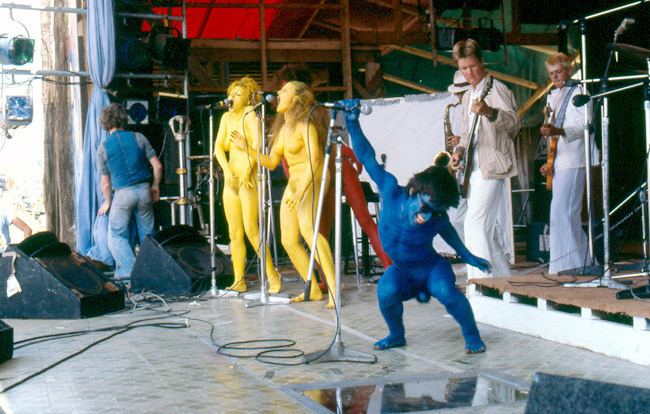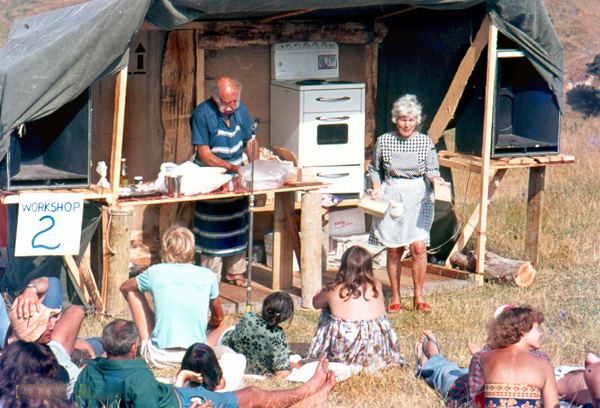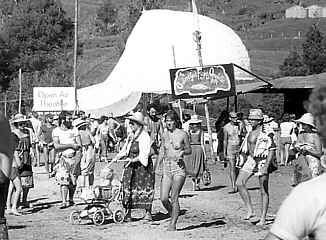Genre Rock music, Years active 1976 - 1981 | Dates January Attendance 75,000+ | |
Location(s) | ||
Nambassa 3 days 1978 new zealand video pic grabs new
Nambassa was a series of hippie-conceived festivals held between 1976 and 1981 on large farms around Waihi and Waikino in New Zealand. They were music, arts and alternatives festivals that focused on peace, love, and an environmentally friendly lifestyle. In addition to popular entertainment, they featured workshops and displays advocating holistic health issues, alternative medicine, clean and sustainable energy, and unadulterated foods.
Contents
- Nambassa 3 days 1978 new zealand video pic grabs new
- Nambassa hippie festivals new zealand 1979 1
- Significant events
- Performers and guests
- Cultural guests
- Arts self sufficiency and healing arts workshops
- Village market
- Personnel
- Sound and lighting
- Interesting occurrences from the Nambassa festivals
- The Nambassa Winter Show with Mahana
- New Zealands Housetruckers of the 1970s
- References

The New Zealand hippie movement was part of an international phenomenon in the 1960s and 1970s, heralding a new artistic culture of music, freedom and social revolution where millions of young people across the globe were reacting against old world antecedents and embracing a new hippie ethos. Specifically New Zealand's subculture had its foundations in the peace and anti-nuclear activism of the 1960s where hippies were actively trying to stop New Zealand's involvement in the Vietnam war and to prevent the French from testing nuclear weapons at Mururoa atoll in French Polynesia in the Pacific Islands.

The January 1979 three-day music and alternatives festival, held over Auckland anniversary weekend, attracted over 75,000 patrons making it the largest arts, multiple cultural and popular music event of its type in the world.

Nambassa is also the tribal name of a charitable trust that has championed sustainable ideas and demonstrated practical counterculture ideals, a spiritually based alternative lifestyle, environmentalism and green issues from the early 1970s to the present.

Nambassa hippie festivals new zealand 1979 1
Significant events

Performers and guests
Some of the hundreds of performers and guests who took part in Nambassa activities included:
Cultural guests
Arts, self-sufficiency and healing arts workshops
The notion for education-based workshops and displays developed out of a philosophical view; that the world was heading towards difficult times and that people needed to learn how to become more self-sufficient so that they would be less reliant on a system unable to provide spiritual and survivalist needs. If one was unable to access healthy food then the logical solution was to learn how to grow one's food. Nambassa was actively promoting widespread Counterculture, Sustainable living, Holistic health and environmentalism, 30 years before Green politics was integrated into mainstream popular culture.
The following extracts are taken from the first 1976 "Nambassa Sun" newsletter proposal, in support of their survivalist workshops on self sufficiency and to heal the body and the mind. Written 30 years ago and published throughout New Zealand in 1976-77, the sentiments expressed by these warnings on impending times have in the view of Nambassa aspirants considerable meaning thirty years later, in a world ravaged by environmental degradation (unprecedented pollution and Global warming) and the systems social collapse. (Unprecedented consumer madness, crime, mental illness, cancer epidemics, substance abuse including pharmaceutical and prescription drug dependence, youth suicide, political and economic corruption and Child sexual abuse).
The Nambassa festivals were not only music and entertainment events but included educational components which sought to instruct people on lifestyle aids it felt important enough to promote within the then conservative society of New Zealand's 1970s. Many of those involved in Nambassa aspired to the notion that throughout the evolution of western civilisation, many valuable ancient survival, healing and spiritual techniques, had been lost over 1700 years of a philosophically and culturally dominating Roman Christianity. Nambassa advocates that many past civilisations supporting religious and political institutions, have historically sought to alienate, and too often violently eliminate, many worthwhile belief systems which did not conform to its then strict conservative doctrines on culture and religion. Adherents of Nambassa promote the ideology which suggests that, to deny what was once integral to survival in ancient history, is essentially to deny ones personal spiritual development. Through its wide variety of workshop subjects, the festivals attempted to nurture a better understanding of culture and spirituality with the goal of fostering a more tolerant and better informed society.
The idea of integrating education based workshop demonstrations with popular mainstream entertainment, set the Nambassa festivals aside from other festivals coming before it. It was during the social revolution of the early 1960s and 1970s that Nambassa pioneered the concept, and was a world leader, in what was to evolve as a new format of presentation for the all encompassing major cultural, creative arts and music festivals. Most large open-air entertainment gatherings, prior to Nambassa, were essentially pop concerts. This new format demonstrated the merits of combining, in a complementary way, multiple and diverse entertainment and cultural modules, within the one grand celebratory event. During the 1970s, the Nambassa Trust developed this concept of large scale multidimensional events, which the rest of the world only began adopting some 20 years later.
While the 1960s and 1970s hippy movements were, and continue to be, unfairly derided for their infatuation with rediscovering ancient religion and culture, many of these re-birthing systems are now part of mainstream ideology. Although the subject matter of the workshops at Nambassa was controversial for the time, these once-alternative ideas are now accepted by many as integral components of a freethinking modern society. The biggest complaint against the festival organisers from festival patrons, was that there were never enough hours in the day to attend their desired programme.
At Nambassa, one could attend and participate in free workshop demonstrations, symposium and discussion groups on diverse subjects such as: leather-work, hand crafted jewelry, spinning (textiles), pottery, indigenous Australians didgeridoo, boomerang throwing, creative art, musical instruments, puppeteering, bonsai trees, batiking, screen printing, basket weaving, Māori woodcarving, furniture and woodturning, natural cosmetics, custom made Sandal (footwear), clay therapy, aboriginal emu egg carving, silk screening, crochet and embroidery, macramé, ceramics, bone carving, candle making, stained glass, paper making, journalism and printing, glass blowing, enamelling, Māori art and jewelry, wood carving, the art of throwing pottery, weaving on inkle and back strap looms, wood-adzing, moccasin making, airbrushing, organic gardening, tie-dye, Māori kit making, mulching and composting, growing and using soya beans, herb gardening, hydroponics, small orcharding, natural child birth, breast feeding, child care, alternative education, animal husbandry, raku pottery, fencing, small dams and irrigation, solar heating, methane gas plants, wind pumps and generators, solar power, solar cooker, waterwheels, goat farming, sheep milking, rammed earth walls, soil-cement adobe, stone-masonry, hydraulic power, wind power, low cost housing and renovation, furniture making, moulds and mud houses, bamboo and its uses, alternative lifestyles and communities, Rudolf Steiner Schools, permaculture, ecology and mining, native forests, saving the whales, food preparation and storage, dried fruit, bread making, self-sufficiency, wine making, beekeeping, butter and cheese making, soap making, food cooperatives, healthy eating, civil liberties, New Zealand's nuclear-free zone, world peace and disarmament, music, puppetry, origami, theatre, dance and costumes, mask making, conservation and pesticides, clean water, mobile homes construction, bush craft, legal aspects of alternative land development, horse ploughing, family planning, vegetarianism, animal rights, martial arts, Third World poverty, civil and human rights, work cooperatives, craft cooperatives, wood gas producers, solar panels, development of electric cars and bikes, women's issues, amateur radio, wood stoves and wetbacks, kite making, the environment (Greenpeace and Friends of the Earth), alternative education, Pacific cultural exchange (Pacific Islander), Māori land rights, community development, Māori marae, Māori hangi, substance abuse, new age and green politics, alternative media, meditation, yoga, sufi dancing, I Ching, tarot cards, alchemy, massage, sweat lodge, nutrition, alternative medicine, astrology, prayer and chanting, clairvoyance, meditation, spiritual healing, naturopathy, acupuncture, t'ai chi, herbalism, natural remedies, reflexology, iridology and osteopathy.
At all festivals there was a smorgasbord of spiritual and religious learning. Here the public could venture to various Healing Arts areas and attend either a bible study course, or chant spiritual names with the Buddhists and Hare Krishna's, or sing and pray with Christians, or attend Sunday mass with the Catholics or learn how to meditate with Ananda Marga or find out the meaning of Karma from the Hindus. The policy of the Nambassa Trust was to attempt to create an ambiance which would dispel all religious factionalism, so that philosophical labels could dissipate enabling people of all religious persuasion to share in their most common fundamental of traits, their humanity. In maintaining Nambassa's nonsectarian and open door policy on religious philosophy, workshops were conducted on: Hinduism, Hare Krishna, Bible scholarship and born again Christianity, Roman Catholic Church, Judaism, Ananda Marga, Buddhism, Taoism, Islam, Krishna-Haribol, Sufism, Esoteric Christianity, shamanism, Wicca, and Zen.
Village market
At the centre of all Nambassa festivals lay the village marketplaces. These consisted of dozens of hand craft outlets and health food eateries. Here the hustle and bustle, the exuberant colour and relaxed atmosphere, prevalent at the various Nambassa village marketplaces, was a feature. These centers of community are where one found the main information centre or where folks simply culminated just to absorb the diverse quirky celebratory ambiance. Over the various festivals the marketplaces evolved and became major attractions in themselves. Not only a space for the enjoyment of bartering for the various eclective products and oddities, but they were a place of fun and entertainment, spontaneous or otherwise. The idea of a marketplace servicing the local population, as a method of doing business, buying, selling and exchanging products, is as old as civilization itself.
The 1981 festival village was designed around a central rotunda with a maypole, where spontaneously, poets, buskers and ravers alike featured. Nambassa vigorously promoted handcrafts, not only because of their therapeutic qualities, but because they had the potential to be a source of revenue to lifestyle proponents looking towards self-sufficiency and economic independence. From the festival village one could attend any number of craft workshops, pick up a copy of the daily Nambassa Waves newspaper, go buy fresh bread cooked in the wood-fired oven bakery constructed in a converted hay shed, go do some shopping, check out Radio Nambassaland, pick up some information from the mother centre, or just simply chill out and absorb the atmosphere.
Personnel
The multiple festival format which combined Creative Arts, popular music and multiculturalism that shaped the Nambassa festivals, was conceived by Peter Terry while living in the Waikino craft village during early 1976. January 1977 heralded the Waikino music festival, a prelude to Nambassa, which experimented with the concept of amalgamating into a singular festive event, controversial alternative culture with popular music. By February 1977 Lorraine Ward and Bernard Woods in an old restored farmhouse atop of rural Bulltown Rd in Waihi, assisted Terry to edit a blueprint for the Nambassa Trust and the first festival. The first Nambassa newsletter proposal was printed, ten thousand copies of a free 13-page manuscript outlining the model and need for a Nambassa event, were circulated among the music, arts and alternative communities throughout the nation, inviting the wider community to participate. The first Mother Centre was opened on a farm in Willow Road at Waihi early November 1977, where the initial Nambassa support base and volunteers assembled to construct the festival facilities to accommodate a small city for the planned three-day music, crafts and alternative lifestyle event which was to be held at the end of January 1978 on two farms at the end of Landlyst Waihi.
The Nambassa administration involved hundreds, to the extent that the 1981 five-day celebration gave out 1500 complimentary tickets to people and groups involved in the event in some official capacity. Those mainly responsible were: Peter Terry (Nambassa trustee, founder and events coordinator 1976-2005), Lorraine Ward (Nambassa secretary and trustee 1977-2005), Neil Wernham (art and graphics 1977-1981), Doug Rogers (music and staging technical adviser, 1976–1979), Fred Alder (Nambassa sun coordinator 1979, 1978 construction team, and former trustee 1978 and 1979), Bryce Lelievre (1981 festival secretary), Mike Taylor (communications and site coordinator 1978 and 1979), Jonathon Acorn (1981 Woozlebub coordinator), Trevor Kotlowski (1981 goffa), Mike Colonna (children's facility coordinator 1978 and 1979), Colin Broadley (programing, Nambassa book coordinator and open-air theatre 1979-1981) and Barry Lowther, (Mother Centre father, 1978 and 1979).
The organising of the festivals and supporting events were themselves practical workshops in every sense. The Nambassa spectacles were organised on a purely voluntary basis by energetic and visionary young unemployed hippies (at a time when New Zealand's unemployment rate was at an unprecedented high), coordinated into a cohesive working force by Terry. Three months out of each festival its supporters would assemble at a farm community called the "Mother Centre", living in house trucks, vans, cars and tents. Nambassa's open door policy encouraged anyone of whatever race, creed or economic circumstance to join in, providing one met the basic rules of the Mother Centre camp. The guidelines were no alcohol or hard drugs, and vegetarian diet was supplied by the Trust. Participants were required to work each day towards the collective goal of preparing the festival in time for opening day. In exchange they were fed and had immediate needs catered for. Over the years thousands of people, young and old, carved out permanent careers from the inspiration learnt, just from being involved with or going to a Nambassa event.
Nambassa is administered not by private enterprise but through a registered charitable trust whose articles list provisions and aims allowing it to organise public events to raise funds to meet objectives. Consequently, the organisation is nurtured by and for the people, as opposed to being driven by corporate interests looking to maximise profit. This effectively enabled the events organisers to set minimal entry fees, based upon projected profits, so that festivals were affordable to lower income people. For example, the 1979 festival entrance was $18 (pre-paid) for a three-day adult pass. The trustees have several times declined offers of corporate sponsorship because the products offered have not met the Trust's philosophical aims and objects. In the 1970s the Nambassa Trust donated $29,698 to other organisations which meet its criteria. All Nambassa events made a profit with the exception of Celebration 1981.
Sound and lighting
Nambassa significantly expanded the concept of multiple open air staging, all running simultaneously at the one event. Out of the first 1978 three-day festival, the requirement of a second stage grew from the need to expand the entertainment program because of the resounding feedback from local performers and artists wanting to play at Nambassa. This became the "Aerial Railway", a second fully operational stage with sound, lighting and management. Aerial Railway absorbed the overflow of performers from the Main Stage, and also acted as a venue for spontaneous performances or raves. This second option was integral to the Nambassa philosophy of promoting local music and arts. Although the Miami Pop Festival in December 1968 featured two simultaneous 'main' stages, most of the early U.S. and European rock festivals, including Woodstock festival, Monterey Pop Festival and Isle of Wight Festival were predominantly single stage productions. The Nambassa 1978 festival had three stages; 1979 saw this expanded to four (including workshop stages), and the 1981 5-day celebration heralded five separate sound and lighting venues, all running at the same time. In 1981, "Aerial Railway" was replaced with the "Open Air Theatre" and "Woozlebub" for children. The multiple staging concepts seem to be finally making a comeback in the 21st century as seen at the recent Big Day Out and Glastonbury festivals.
The 1981 Nambassa 5-day event introduced "Radio Nambassaland". This broadcast live feeds from all the 5 stages and workshops, into the surrounding community.
Interesting occurrences from the Nambassa festivals
The Nambassa Winter Show with Mahana
The Nambassa Winter Show with Mahana was a musical theatrical production of 60 entertainers and crew who toured the North Island of New Zealand in a convoy of Mobile homes, buses and vans, performing at major centres and theatres throughout September and October 1978. While initially 4 main shows were scheduled for this collective theatre company, repeat and spontaneous performances around the nation saw this number of live performances increased to over 10. This theatrical extravaganza was organised by the Nambassa Trust as part of its national promotion of the arts and towards promoting its 1979 3 day music, crafts and Alternative lifestyle festival which was held in Waihi attracting 70,000 people.
New Zealand's Housetruckers of the 1970s
New Zealand's Housetruckers of the 1970s . Housetruckers are individuals, families and groups who convert old trucks and school buses into mobile-homes and live in them, preferring an unattached and transient gypsy lifestyle to more conventional housing. These unique vehicles began appearing around New Zealand during the mid-1970s and even though there are fewer today they continue to adorn NZ roads.
